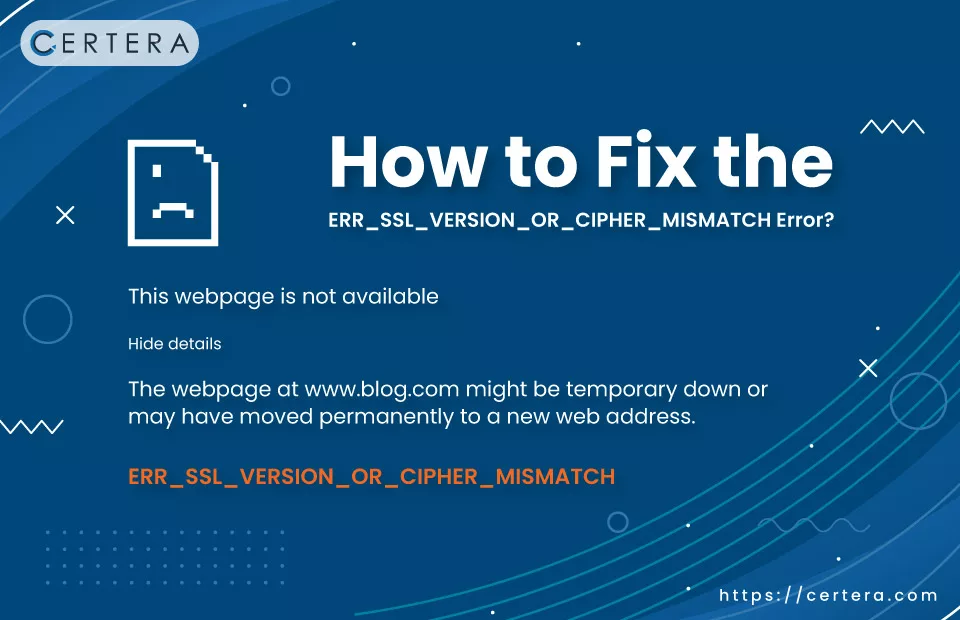How to Fix the ERR_SSL_VERSION_OR_CIPHER_MISMATCH Error?

Have you encountered the ERR_SSL_VERSION_OR_CIPHER_MISMATCH error while working on a browser? If affirmative, you must know how frustrating and troublesome it can be. Therefore, this article will explore everything about this error.
What is the ERR_SSL_VERSION_OR_CIPHER_MISMATCH?
In a browser, the ERR_SSL_VERSION_OR_CIPHER_MISMATCH error appears due to a lack of “common SSL protocol version or cipher suite support” between a web server and a user’s browser. This issue happens during the TLS handshake process. With that, the browser will automatically display this specific error message.

What are the Reasons Behind the Occurrence of this Error?
Apart from the mismatch between TLS versions or cipher suites, the ERR_SSL_VERSION_OR_CIPHER_MISMATC error can occur due to “n” a number of other reasons. Here are some of those:
- Outdated browsers or operating systems.
- Use of old TLS versions, significantly older than TLS 1.2.
- Web servers employ the outdated RC4 cipher suite.
- Corrupted SSL state within the browser.
- Antivirus software interfering with SSL protocols.
- SSL certificate issues like mismatches or incorrect installations, etc.
How to Fix ERR_SSL VERSION OR CIPHER MISMATCH Error?
Here are the methods that you can use to fix the issue:
Method 1: Check the SSL Certificate
Start by examining the website’s SSL certificate. An outdated or invalid certificate often leads to this error. Tools like Qualys SSL Labs can help check your site’s SSL status. This tool grades the SSL connection and detects mismatches or outdated certificates.
Follow the straightforward steps mentioned below to accomplish the same:
- Open a fresh tab in Chrome.
- In the address bar, type https://www.ssllabs.com/ssltest/.
- Press Enter.
- In the Hostname field, type the website’s URL and press Enter.
Method 2: Update Browser and Operating System
Older versions might not support newer SSL protocols and lead to mismatches. These mismatches ultimately lead to the ERR_SSL_VERSION_OR_CIPHER_MISMATCH error. Therefore, regularly update your browser and the operating system that you utilize. Follow the steps mentioned below to update your browser and OS:
Steps to update your browser:
- Open a fresh tab in Chrome.
- Click on Customize and control Google Chrome icon (three vertical dots).
- From the list, select Help, and click About Google Chrome.
- The update will start automatically if it’s not the – “latest version.”
Steps to update your OS:
- Click on the Search button placed on the taskbar.
- Type Windows Update settings and press Enter.
- Click on the Check for updates button.
Method 3: Clear Browser Cache
Cached data might contain outdated security configurations. These outdated security configurations can give rise to many SSL-related errors, along with the one in the discussion. Follow the steps mentioned below to clear the browser cache:
- Open a fresh tab in Chrome.
- Click on Customize and control Google Chrome icon (three vertical dots).
- From the list, select More Tools, and click Clear browsing data.
- In the Clear browsing data dialog box, select the Time range from the list.
- Check the checkbox before the Browsing history option.
- Check the checkbox in front of the Cookies and other site data option.
- Check the checkbox in front of the Cached images and files option.
- Click Clear data.
Method 4: Disable Antivirus Temporarily
Incorrect settings or the software’s certificates often flag safe sites as risky. To test if it’s the cause, follow the steps given below to turn off Windows antivirus software. Once done, retry reaccessing the website.
Follow the steps given below to disable Windows antivirus software:
- Click on the Search button placed on the taskbar.
- Type Virus & Threat Protection and press Enter.
- Toggle off the switch placed under the Real-time protection option.
Method 5: Enable TLS 1.3 Support
Enabling TLS 1.3 in your browser can fix this issue. TLS 1.3 is the latest version of TLS that offers enhanced security and performance. Follow the steps mentioned below to enable it:
- Open a fresh tab in Chrome.
- In the URL bar, type chrome://flags.
- Press Enter.
- In the Search flags bar, type TLS.
- Press Enter.
- From the TLS 1.3 hybridized Kyber support list, select Enable.
Method 6: Configure SSL with Cloudflare
Misconfigurations with Cloudflare’s SSL settings can lead to the error in discussion. Check Cloudflare’s dashboard for any SSL-related settings and make necessary adjustments.
Follow the steps mentioned below to adjust Cloudflare’s SSL settings if Universal SSL is installed from Cloudflare:
- Enter your credentials to log in to your Cloudflare dashboard.
- Click SSL/TLS on the top panel.
- Navigate to the Edge Certificates tab > Disable Universal SSL.
- In the right column, click Disable Universal SSL.
- Wait for 2 to 3 minutes (for the process to complete).
- Click Enable Universal SSL.
- Login into the Cloudflare dashboard if needed.
- Click Caching placed at the top.
- Click Configuration.
- From the Purge Cache section, click Purge Everything.
Method 7: Disable QUIC Protocol
The QUIC protocol, though efficient compared to – TLS, TCP, HTTP/2, etc., can sometimes cause ERR_SSL_VERSION_OR_CIPHER_MISMATCH and other SSL-related errors. So, it’s best to disable it. Follow the steps mentioned below to turn off QUIC protocol:
- Open a fresh tab in Chrome.
- In the URL bar, type chrome://flags.
- Press Enter.
- In the Search flags bar, type QUIC.
- Press Enter.
- From the Experimental QUIC Protocol list, select Disable.
Conclusion
Tackling the ERR_SSL_VERSION_OR_CIPHER_MISMATCH error is straightforward. Regularly update your browser and OS. Always check and clear your browser cache. Temporarily disable antivirus software if needed. Enable TLS 1.3 for enhanced security. Adjust Cloudflare’s SSL settings carefully. Lastly, consider disabling the – QUIC protocol.